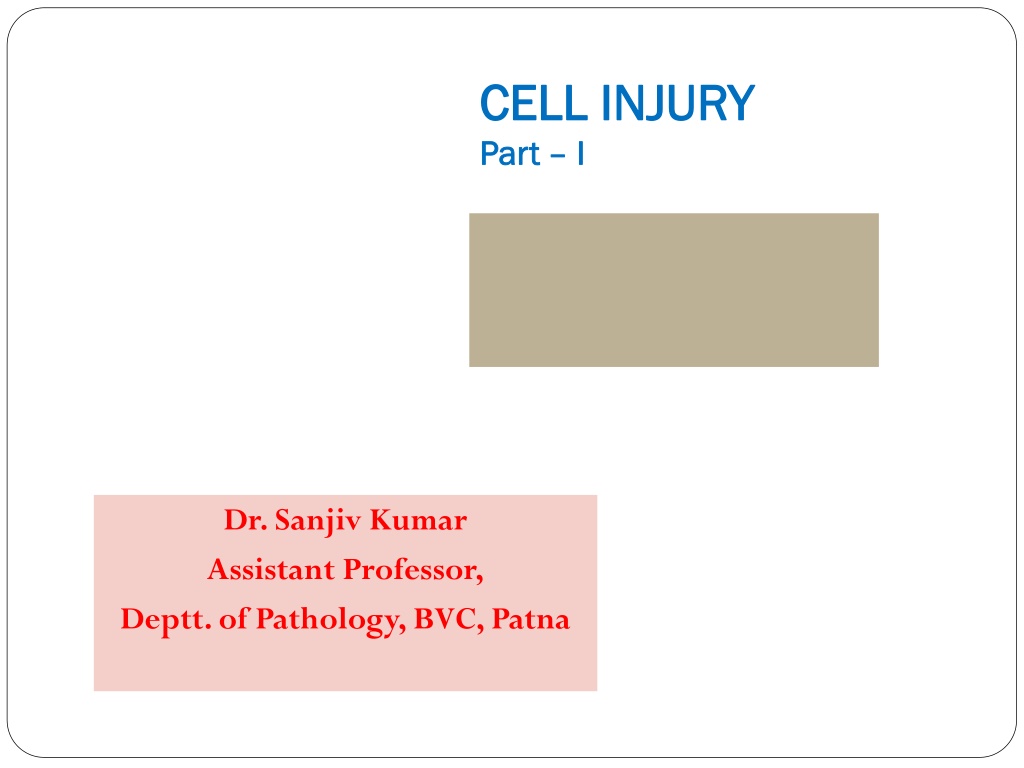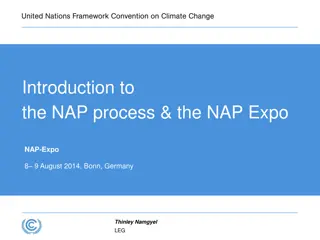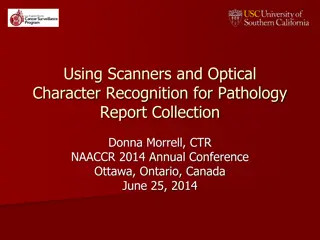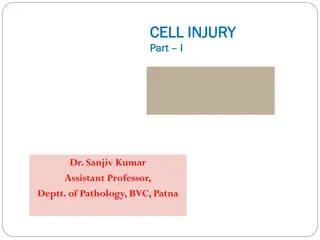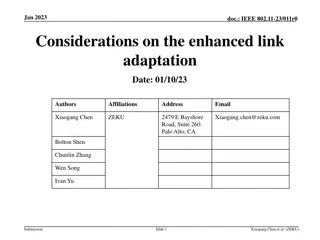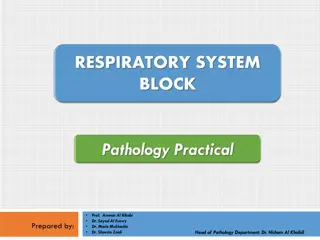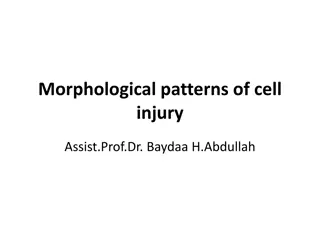Understanding Cell Injury and Adaptation in Pathology
Rudolph Virchow's concept of disease starting at the cellular level highlights how cells constantly face challenges in maintaining homeostasis. The plasma membrane acts as a barrier against external stressors, but when cells face excessive physiological stresses or pathological stimuli, they adapt or may undergo reversible or irreversible injury. Cell death occurs when stress exceeds adaptive capacity. Causes of cell injury include hypoxia, physical agents (trauma, temperature extremes), and chemical agents or drugs. Understanding these processes is crucial in pathology studies.
Download Presentation

Please find below an Image/Link to download the presentation.
The content on the website is provided AS IS for your information and personal use only. It may not be sold, licensed, or shared on other websites without obtaining consent from the author. Download presentation by click this link. If you encounter any issues during the download, it is possible that the publisher has removed the file from their server.
E N D
Presentation Transcript
CELL INJURY CELL INJURY Part Part I I Dr. Sanjiv Kumar Assistant Professor, Deptt. of Pathology, BVC, Patna
INTRODUCTION Rudolph Virchow, 'Father of Cellular Pathology', put forward the concept that disease begins at the cellular level. The normal cell lives in a hostile environment In other words, it exists in a state of striking disequilibrium with its external environment. For example, the concentration of calcium ions outside the cell is 10,000 times higher than that inside. If all this calcium were to enter the cell, it will prove toxic, and kill the cell. This can happen during cell injury.
It is the plasma membrane of the cell that constitutes the structural and functional barrier, which separates the intracellular from the hostile extracellular environment.
DEFINITIONS The normal cell has to live within a fairly narrow range of function and structure. Even then, 1t is able to handle normal physiological demands, so-called normal homeostasis (L. staying same). Somewhat more excessive physiological stresses, or some pathological stimuli, bring about adaptation. That is, the cell modifies its structure and function in response to changing demands and stresses.
It then acquires a new but steady state and preserves its health. If the adaptive capability is exceeded, or in certain cases when adaptation is not possible, a sequence of regressive changes occurs, collectively known as cell injury (L. re, retro = back; gress = step, i.e., step back, go back, fall in health; also called retrogressive or degenerative changes). Within certain limits, injury is reversible and cells return to a normal state, but with severe and persistent stress, the cell reaches a 'point of no return', suffers irreversible injury and then dies.
Adaptation, reversible injury, irreversible injury, and cell death are states of progressive encroachment on the cell's normal function and structure.
Causes of Cell Injury Hypoxia: Hypoxia (loss of oxygen supply) is an extremely important and common cause of cell injury and cell death. It affects cells aerobic oxidative respiration. Physical agents: trauma, extremes of temperatures (burns and deep cold), radiation, electric shock, atmospheric pressure. Physical agents include mechanical and sudden changes in Chemical agents and drugs: Virtually any chemical substance or drug can cause cell injury.
Infectious agents: These agents range from the submicroscopic viruses to the large tapeworms. In between are the bacteria, fungi, rickettsiae, chlamydiae, mycoplasma, protozoa, and higher forms of parasites. Immunological reactions: Although the immune system serves in the defence against infectious agents, immune reactions may also cause cell injury. Examples include anaphylactic reaction to a foreign protein or a drug, and autoimmune diseases. Nutritional imbalances: Nutritional deficiencies such as avitaminoses and others are important causes of cell injury. Ironically, excesses of nutrition are also important causes of morbidity and mortality. Genetic defects: Genetic defects may cause cell injury. The genetic injury may result in a defect as gross as congenital malformations, or in as subtle a change as the single amino acid substitution in haemoglobinS in sickle cell anaemia.
GENERAL CONSIDERATIONS Biochemical mechanisms of cell injury The biochemical mechanisms responsible for cell injury and cell death are complex. All the same, there are certain principles that are applicable to most forms of cell injury. 1. The morphological changes of cell injury become noticeable only after some critical biochemical system within the cell has been deranged. Thus, the first lesion to develop is biochemical (molecular) in nature. This, in turn, causes structural changes first at an electron microscopicallevel (ultrastructural lesion), then light microscopic lesions develop, and these, when extensive, produce gross lesions.
2. The cellular response to injurious stimuli depends on the type of injury, its duration, and its severity. 3. The results of an injurious stimulus depend on the type, status, adaptability, and genetic make-up of the injured cell. The same injury has different result depending on the cell type. 4. Although the exact biochemical site of action for many injurious agents is difficult to determine, four intracellular systems are particularly exposed to attack
(1) Cell membrane. It is on the maintenance of the integrity of cell membrane that the ionic and osmotic homeostasis of the cell and its organelles depends, (2) Oxidative phosphorylation and production of adenosine triphosphate (ATP), (3) Synthesis of enzymic and structural proteins, and (4) Preservation of the integrity of genetic apparatus of the cell. The structural and biochemical components of a cell are so closely inter-related that, whatever the exact point of initial attack, injury at one site leads to wide-ranging secondary effects.
Common Biochemical Mechanisms Common Biochemical Mechanisms With many injurious stimuli the exact pathogenic mechanisms that lead to cell death are incompletely understood. In spite of this, there are several common biochemical pathways in the mediation of cell injury and cell death, whatever the causative agent. These include: ATP depletion: High-energy phosphate in the form of ATP is required for many processes 1. within the cell. ATP is produced in two ways: The major route is oxidative phosphorylation of ADP, a reaction that requires oxygen, and i. ii. the second is the glycolytic pathway that can generate ATP in the absence of oxygen using glucose obtained either from body fluids, or from hydrolysis of glycogen. ATP depletion and decreased ATP synthesis are common consequences of both ischaemic and toxic injury.
2.Lack of oxygen or generation of oxygen-derived free radicals: Partially reduced activated oxygen species are also important mediators of cell death. They are highly toxic molecules that can damage lipids, proteins, and nucleic acids. These molecules are referred to as activated or reactive oxygen species. 3. Loss of calcium homeostasis: Calcium (Ca++) in cytosol is normally maintained at extremely low concentrations. Concentration of calcium in cytosol is up to 10,000 times lower than the concentration of extracellular calcium, or of calcium sequestered (isolated) within mitochondria and endoplasmic reticulum. Ischaemia and toxins increase cytosolic calcium concentration due to a net influx (entry) of extracellular calcium (Ca++) through the plasma membrane, and also because of the release of Ca++ from mitochondria and endoplasmic reticulum. Increased cytosolic calcium, in turn, activates a number of enzymes, with harmful cellular effects.
The enzymes activated by calcium include: i. phospholipases, which cause membrane damage, ii. proteases, which break down structural and membrane proteins, iii. ATPases, which accelerate ATP depletion, and iv. endonucleases, which break down nuclear chromatin. 4. Defects in membrane permeability: The plasma membrane may be directly damaged by certain bacterial toxins, viral proteins, complement components, cytotoxic lymphocytes, and a number of physical or chemical agents. Changes in membrane permeability may also be secondary to a loss of ATP synthesis, or may result from calcium-mediated activation of phospholipases.
5. Mitochondrial damage: Since all cells depend on oxidative metabolism, mitochondrial integrity is most important for cell survival. Irreparable damage to mitochondria will ultimately kill cells.
